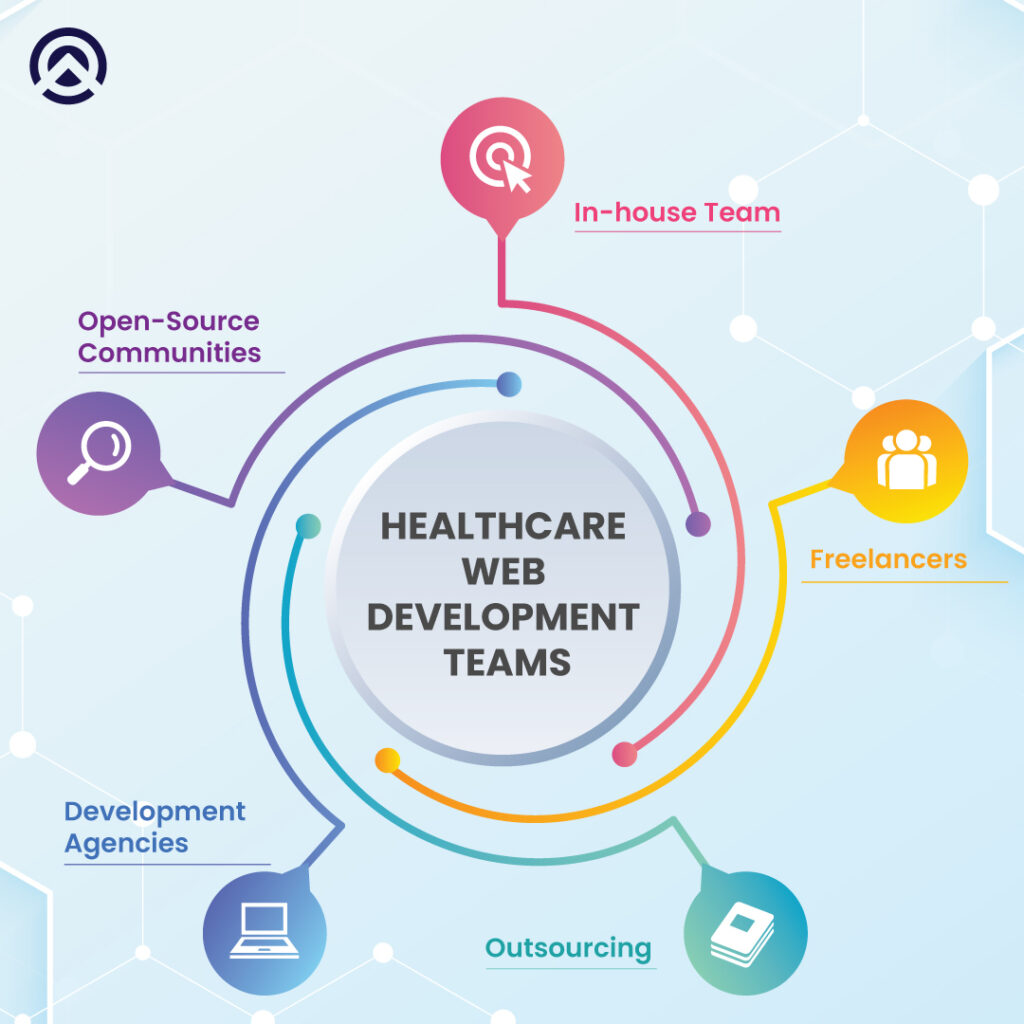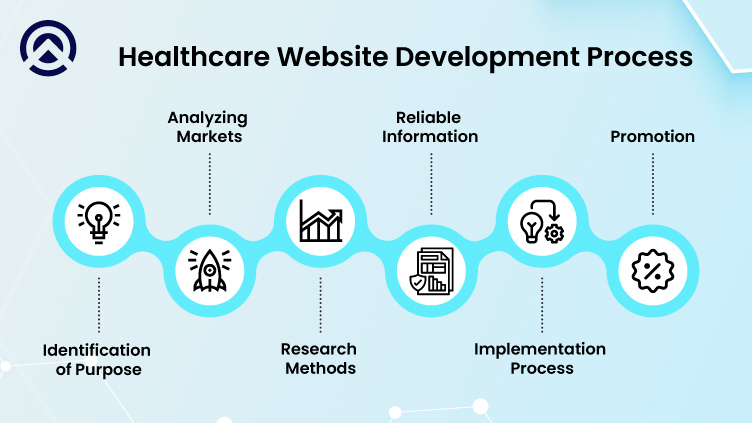HealthCare Website Development in 2025: A Comprehensive Guide
Now, patients are becoming smart as they begin to notify their symptoms and search over the internet about key measures to rectify them. In reality, patients begin to conduct an extensive search before landing on a decision to connect with a specific healthcare provider.
So, if you’re a doctor or physician then you need a website so that you can provide your services to thousands of patients. From the revenue cycle perspective, the healthcare segment is projected to reach $60.22 billion by the year 2024. By 2027, it is projected to reach up to $92.01 billion with a CAGR rate of 10.95%.
Here, we want to clarify that at Amplework we believe that healthcare professional is completely related to moral services & healthcare professionals are not meant to become fascinated by seeing the increasing revenue figures. Although, by explaining the “revenue forecasted statistics” in the above paragraph – we also intend to give complete information about the future growth of the healthcare industry.
If you are also eager to develop a healthcare website for your clinic or hospital then this complete guide will help you to understand each fold. So, let’s understand about key aspects of healthcare website development.

Difference Between a Health Website and a Medical Website?
A health website is typically focused on providing information and resources for maintaining a healthy lifestyle and preventing illnesses. These websites may cover topics such as nutrition, exercise, mental health, and disease prevention. Health websites may also offer tools and resources such as calorie trackers, exercise programs, and symptom checkers.
On the other hand, a medical website is typically focused on providing information about specific medical conditions, diseases, and treatments. Medical websites may be geared towards healthcare professionals or patients and may include information about symptoms, diagnosis, treatment options, and research related to specific conditions.
For your better understanding about medical web development and healthcare web development, we have created a table with all the criteria and relevant factors:
| Criteria | Healthcare Website | Medical Website |
Focus | Promoting overall health and well-being. | Providing information about specific medical conditions, diseases and treatments. |
Topics Covered | Nutrition, exercise, mental health, disease prevention, healthy lifestyle choices. | Symptoms, diagnosis, treatment options, research related to specific medical conditions. |
Audience | General public. | Healthcare professionals, patients & caregivers. |
Tone and Language | Generally less technical and easier to understand for non-medical professionals. | More technical and medical jargon may be used. |
Information Depth | Covers a wide range of topics, but information may not be as detailed or in-depth as medical websites. | Provides detailed and in-depth information related to specific medical conditions, diseases and treatments. |
Goal | Encourages healthy lifestyle choices and disease prevention. | Helps patients and healthcare professionals to better understand specific medical conditions, diseases, and treatments to make informed decisions. |
Examples | WebMD, Healthline, Mayo Clinic. | Medscape, UpToDate, National Institutes of Health (NIH). |
Main Features to Integrate During Healthcare Website Development
To make your application stand out in the market there are certain key features that you need to integrate into your medical website – such as:
| Functionalities | Description |
Patient Registration and Profile Management | This feature allows patients to register and create a profile within the healthcare application, which includes their personal information, medical history, and insurance details. |
Telemedicine and Video Consultations | This feature allows patients to schedule and attend virtual appointments with healthcare providers via video consultations, allowing for remote diagnosis, treatment, and follow-up care. |
Electronic Medical Records (EMR) | Your patients will create and manage electronic medical records for their patients, including medical history, allergies, test results, and prescriptions. |
Prescription Management | Healthcare providers manage patient prescriptions electronically, including writing and sending prescriptions to pharmacies, tracking medication adherence and sending refill reminders to patients. |
Health Monitoring and Tracking | This feature allows patients to monitor and track their health metrics – such as: blood pressure, heart rate and blood sugar levels. |
Health Education and Information | Access to reliable health information and educational resources, including articles, videos, and interactive tools, to help them make informed decisions about their health. |
Health Surveys and Assessments | During your healthcare enterprise web development emphasize this feature because your patients or visitors to pass feedback to you via digital format. |
Lab Test Results | It will help in faster and more accurate diagnoses with treatment measures. Patients can also access their own lab test results through the healthcare application. |
Advance Features to Integrate During Healthcare Web Development
In order to gain competitive advantages, your website needs to stand out in the market, your website should showcase an advanced level of functionalities. We have outlined some next-generational features that you need to consider during medical web development. You can also take use of MVP development for generating early-stage feedback about these functionalities for your website.
| Advance Functionalities | Description |
Artificial Intelligence (AI) | AI can be used to help healthcare providers make more accurate diagnoses, identify health risks, and personalize treatment plans based on patient data. |
Blockchain Technology | This functionality involves using blockchain technology in your health app development & website development to securely store and share patient data across a network of users. |
Wearable Device Integration | It involves integrating wearable devices, such as fitness trackers or smartwatches, with the healthcare application to allow for real-time monitoring and tracking of patient health data. |
Voice-Enabled Technology | Connect with an expert healthcare website development company so that you can offer a voice-enabled command system to your patients. |
Augmented Reality (AR) and Virtual Reality (VR) | Integration of AR/VR during medical website design and development will be going to help you to astonish your patients with the tech-enabled solution. |
Read more: Unraveling the Cost of Developing a State-of-the-Art Telemedicine Platform
Healthcare Web Development Teams

When selecting a healthcare development team, it’s important to consider factors such as experience, expertise, communication, and cost. You should also look for teams with experience in healthcare development and a proven track record of delivering successful projects.
1. In-house Team
You can hire a team of developers, designers, and other professionals to work in-house on your healthcare development project. This option provides complete control over the development process and allows for seamless communication and collaboration among team members.
Cost Aspect: The cost of building a healthcare website with an in-house team can range from $100,000 to $500,000 or more depending on the size and complexity of the project.
2. Freelancers
You can hire full stack developers to work on your healthcare development project. This option is more cost effective than hiring an in-house team, and you can select specific freelancers with the skills and experience required for your project.
Cost Aspect: Freelance developers can cost anywhere from $50 to $250 per hour depending on their experience and skill set. The cost of building a healthcare website with a freelance developer can range from $5,000 to $50,000 or more depending on the project scope and complexity.
3. Outsourcing
You can outsource your healthcare development project to a third-party vendor. This option provides access to a large pool of talent and expertise, often at a lower cost than hiring an in-house team. However, communication and collaboration may be more challenging, as the development team may be located in a different time zone or speak a different language.
Cost Aspect: The cost of building a healthcare website with an offshore team can range from $10,000 to $100,000 or more depending on the project scope and complexity.
4. Development Agencies
You can hire a healthcare development agency to work on your project. This option provides access to a full team of professionals with experience in healthcare development. Agencies typically offer a range of services, from design and development to testing and deployment.
Cost Aspect: The cost of building a healthcare website with a development agency can range from $50,000 to $500,000 or more depending on the project scope and complexity.
5. Open-Source Communities
You can utilize open-source communities to develop your healthcare project. This option provides access to a large community of developers who can contribute code, collaborate and provide support.
Cost Aspect: It is the most budget-friendly method to develop healthcare website or applications. However, you will need to input a lot of your efforts and support for the cost aspect.
Development Process of Healthcare Website

To develop a fascinating website you need to travel through a series of processes for healthcare website development. As, your journey will be eased if you will have an understanding of the process.
Step 1: Identify the purpose of your healthcare website
The purpose of your website development will be going to impact your development process. Your purpose of website development should be clear and you need to research for functionalities that need to be present in your website.
Note: In the above section, we have already discussed about basic & advanced functionalities that you can consider during your hospital website design and development.
Step 2: Analyze local or outsourcing companies at the global level
Due to globalization, every province or country holds a massive amount of talent for different domains. Thus, we have prepared a list of countries with the average hourly rates of developers:
| Country | Average Hourly Rate (Currency Unit: “$”) |
| United States | $50 – $70. |
| Canada | $50 – $80. |
| United Kingdom | $75 – $200 |
| Australia | $100 – $150 |
| Western Europe | $100 – $200 |
| Eastern Europe | $30 – $100 |
| India | $20 – $50 |
| Philippines | $15 – $50 |
| Brazil | $20 – $60 |
Select 3: Research for cost-effective methods
We have outlined 4 extensive cost-effective methods which will help you to opt for budget-friendly solutions.
Custom Development
This method involves hiring a team of web developers to build a healthcare website from scratch. The cost of this method can vary widely depending on the complexity of the website, the experience of the development team, and the location of the development team. In general, custom development can cost anywhere from $10,000 to $50,000 or more.
Content Management System (CMS)
A CMS such as WordPress or Joomla allows you to build a website using pre-built templates and plugins. This method can be less expensive than custom development, with costs ranging from $1,000 to $10,000 or more depending on the complexity of the website.
Website Builders
Website builders such as Wix, Squarespace, and Weebly offer drag-and-drop interfaces that allow you to build a website without any coding knowledge. These platforms can be very affordable, with costs ranging from $10 to $50 per month depending on the features you need.
E-commerce Platforms
E-commerce platforms such as Shopify or Magento can be used to build healthcare websites that offer products or services for sale. The cost of these platforms can vary depending on the features you need, but in general, they can cost anywhere from $29 to $299 per month.
| Method | Estimated Cost |
| Custom Development | $10,000 – $50,000+ |
| Content Management System | $1,000 – $10,000+ |
| Website Builders | $10 – $50/month |
| E-commerce Platforms | $29 – $299/month |
Step 4: Information should align with medical centers
In the USA, the legal authority that monitors healthcare websites and the handling of healthcare information is the Department of Health and Human Services (HHS), specifically the Office for Civil Rights (OCR). The OCR is responsible for enforcing the Health Insurance Portability and Accountability Act (HIPAA).
So, during the fitness app development or health website development, you need to make sure that all the information should be in accordance with the legal medical authorities. It will be going to enhance the credibility of your website effectively.
Step 5: Implementation of different phases
The development of a healthcare app typically goes through several phases, each with its own set of tasks and objectives. Here are the most common phases of healthcare app development:
- Planning: This phase involves defining the goals and objectives of the healthcare app, identifying the target audience, and determining the app’s core features and functionalities. This is also the phase where the development team will create a detailed project plan and timeline.
- Design: In this phase, the development team will create the visual design and user interface (UI) of the app. This includes creating wireframes, prototypes, and mockups to show how the app will look and function.
- Development: Once the design is finalized, the development team will start building the app. This phase includes creating the app’s backend, setting up databases and servers, and writing the code for the app’s features and functionalities.
- Testing: Before the app is released to the public, it must go through rigorous testing to ensure that it is free of bugs and works as intended. This includes both manual testing by the development team and automated testing using tools and frameworks.
- Deployment: Once the app has been thoroughly tested and is deemed ready for release, it will be deployed to the app store or other distribution channels. This includes submitting the app to the app store for approval, setting up hosting and infrastructure, and making the app available for download.
- Maintenance: After the app is released, the development team will continue to monitor and maintain it. This includes fixing bugs, updating features, and ensuring that the app is compatible with new operating systems and devices. At Amplework, we believe that maintenance is an integral part of your wellness app development & website development process.
Read more: How to Develop a Health Insurance Application? Cost, Key Features & Process
Step 6: Promotion among the targeted audience
- Ask for reviews from healthcare consumers.
- Build physician referrals into your medical marketing plans.
- Search Engine Optimization (SEO).
- Social Media Marketing.
Conclusion
In conclusion, developing a healthcare website involves various cost factors that need to be considered before starting the project. By understanding these factors, healthcare providers and website developers can work together to create a high-quality website that meets the needs of patients and healthcare professionals.
So, connect with Amplework to invest in a budget-friendly and well-designed healthcare website can bring numerous benefits – such as: increased patient engagement. patient satisfaction, improved healthcare outcomes and many more endless possibilities.


 sales@amplework.com
sales@amplework.com
 (+91) 9636-962-228
(+91) 9636-962-228





